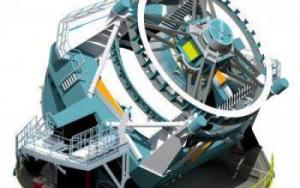Aug 12 2014
Construction of the highly anticipated Large Synoptic Survey Telescope (LSST) can begin now that the National Science Foundation (NSF) has finalized funding. To be located in Chile, LSST is a proposed 8-meter wide-field survey telescope that will image the entire visible sky approximately twice per week, providing an unprecedented amount of information while transforming the emerging discipline of data-enabled science.
 LSST's images will trace billions of remote galaxies, providing multiple probes of the mysterious dark matter and dark energy. Credit: LSST/NSF/AURA
LSST's images will trace billions of remote galaxies, providing multiple probes of the mysterious dark matter and dark energy. Credit: LSST/NSF/AURA
LSST was the highest-ranked ground-based large initiative in the 2010 National Academy of Sciences decadal survey in astronomy and astrophysics. The project is a partnership among NSF, the Department of Energy (DOE) and a number of private contributors. Additionally, researchers from around the world, not only the United States and Chile, will provide operational support to facilitate LSST's mission.
"LSST is a wonderful example of NSF leading the way by investing in fundamental science that is often high risk but potentially very high reward," said NSF Deputy Director Cora Marrett. "LSST is an investment in trailblazing researchers and tools and will encourage important international collaboration."
Equipped with a 3-billion pixel digital camera, LSST will observe objects as they change or move, providing insight into short-lived transient events such as astronomical explosions or collisions. It will create detailed maps of the Milky Way and of our own solar system, and chart billions of remote galaxies. Its observations will also probe the imprints of dark matter and dark energy.
"LSST promises to transform the practice of many aspects of astronomy and is an example of NSF once again enabling discovery and innovation," said Fleming Crim, assistant director for NSF's Mathematical and Physical Sciences directorate. "Everyone involved is excited about the opportunity to expand our understanding of the universe--from distant exploding stars to nearby asteroids."
"This is not just another telescope," said Diane Souvaine, vice provost for research at Tufts University and former National Science Board chairman of the Committee on Programs and Plans. "What makes LSST so exciting is a data set that will be immediately available to all U.S. scientists and the general public. Tens of thousands of transient events each night will be available to the entire world, reaching social networks, citizen scientists, and students everywhere. This instrument will leave an unparalleled legacy of data and lives touched."
NSF and DOE share responsibilities over the lifetime of the project. NSF will develop the site and telescope along with the extensive data management system as well as coordinate education and outreach efforts. DOE, through a collaboration led by its SLAC National Accelerator Laboratory, will develop the large-format camera. The Republic of Chile, through an agreement with Universidad de Chile, provides the site for the LSST telescope.